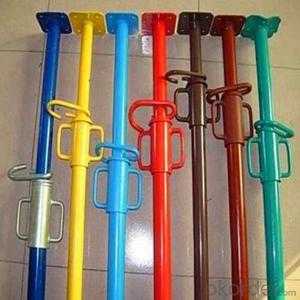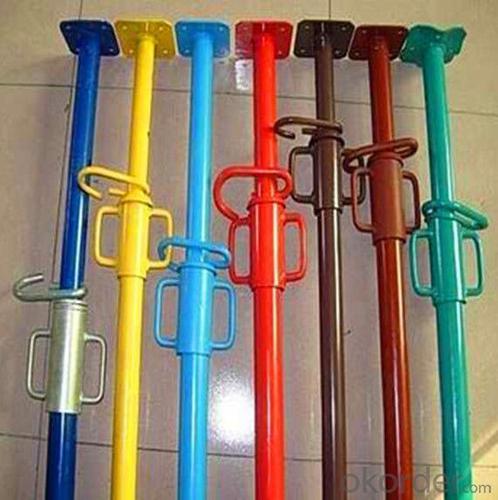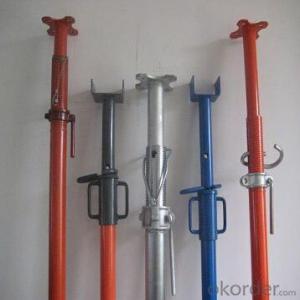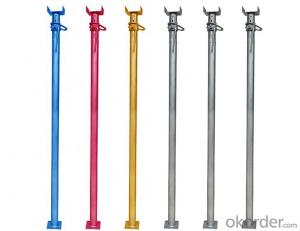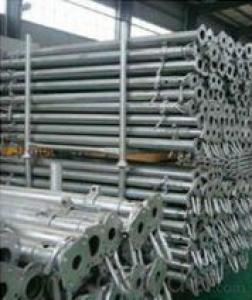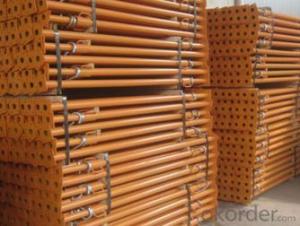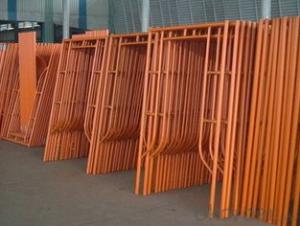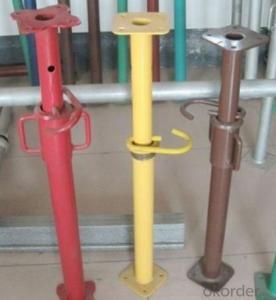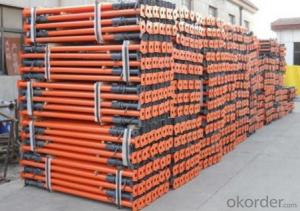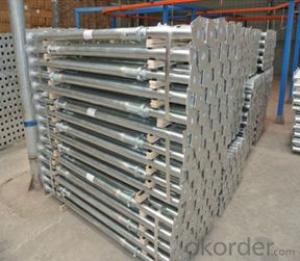Scaffolding Adjustable Steel Prop
- Loading Port:
- China Main Port
- Payment Terms:
- TT OR LC
- Min Order Qty:
- -
- Supply Capability:
- -
OKorder Service Pledge
OKorder Financial Service
You Might Also Like
Quick Details
| Place of Origin: | Model Number: | ||||
| Type: | Scaffolding Part Type: | Material: | |||
| Surface treatment: | Color: | Technique: | |||
| Length: | Inner tube diameter: | Outer tube diameter: | |||
| Thickness: | Application: | Certification: |
Packaging & Delivery
| Packaging Detail: | 1. Adjustable Scaffolding Steel Prop is packed in bundle and wrapped with iron bar. 2. Usually, one 20 GP container can load around 1500-1700 pieces of props. |
| Delivery Detail: | 10-20 days after deposit |
Specifications
Steel Prop
1.Heavy duty steel prop for slab support
2.CO2 arc welded; Anti-rusted surface; Recyclable
3.Factory
4.SGS;BV
Heavy Duty Scaffolding Adjustable Steel Prop
Features
1.An Scaffolding Adjustable Steel Prop consists of internal tube, external tube, prop nut, base plate and top plate.
2. Scaffolding Adjustable Steel Prop can be adjusted to any length within its range which is convenient for using.
3.With its simple structure, Scaffolding Adjustable Steel Prop is easy to assemble and dismantle which can help to save your time, energy, and cost.
4.We have several kinds of Scaffolding Adjustable Steel Prop which are Middle East type Scaffolding Adjustable Steel Prop , Spanish Scaffolding Adjustable Steel Prop and Italian type Scaffolding Adjustable Steel Prop .They are popular in Africa, South America, Asia, and etc.
5. Scaffolding Adjustable Steel Prop is for supporting the concrete slab, beam, timber and formwork which is strong and reliable for interior building construction.
6.We can weld the flat plate or the flower plate at the top of the Scaffolding Adjustable Steel Prop as your requirements.
Specifications
| Name | Scaffolding Adjustable Steel Prop | |||
| Place of Origin | Guangzhou, China | |||
| Brand | AJ or OEM | |||
Size (more customized size available) | Inner tube diameter(mm) | Outer tube diameter(mm) | Adjustable Length | Thickness(mm) |
| 40/48 | 48/56/60 | 1600-2900mm; 1800-3200mm ; 2000-3600mm; 2200-4000mm ; | 1.8/2/2.2/2.5/3 | |
| Material | Q235 carbon steel | |||
| Surface treatment | Hot Dip Galvanized(HDG); cold galvanized; powder coated; dip painted | |||
| Color | Orange, dark red, blue, or as you required | |||
| Welding technique | CO2 arc Welding | |||
| Certification | SGS;BV;EN12810 | |||
| MOQ(Minimum Order Quantity) | 500 pieces | |||
| Payment | T/T | |||
| Delivery time | 20days after deposit | |||
| Package | In bundle and wrapped with iron bar, or as you required | |||
| Production capacity | 100 tons for each day | |||
- Q: How do you dismantle a steel prop safely?
- To safely dismantle a steel prop, follow these steps: 1. Ensure proper safety precautions: Before starting the dismantling process, put on the necessary personal protective equipment (PPE) such as safety goggles, gloves, and a hard hat. Make sure you have a clear work area and have identified any potential hazards. 2. Assess the prop: Examine the steel prop to understand its structure and components. Identify any locking mechanisms, pins, or bolts that need to be removed. 3. Release the load: If the steel prop is supporting any weight, carefully release the load by slowly lowering it onto a stable surface. This will ensure the prop is not under any strain during dismantling. 4. Remove any locking mechanisms: Steel props often have locking mechanisms that secure their components together. Locate and remove any locking pins, bolts, or nuts using the appropriate tools, such as wrenches or spanners. 5. Disassemble the prop: Once all locking mechanisms are removed, begin disassembling the prop by separating its components. Start from the top and work your way down, carefully unscrewing or unbolting each section. 6. Follow the manufacturer's instructions: Some steel props may have specific instructions or guidelines provided by the manufacturer for safe dismantling. If available, consult these instructions to ensure you are following the recommended dismantling procedure. 7. Use mechanical aids if necessary: Depending on the size and weight of the steel prop, you may need to use mechanical aids such as cranes, hoists, or lifting equipment to safely handle and move the components during dismantling. 8. Store or dispose of the components: Once the steel prop is fully dismantled, organize the components in a safe and organized manner. Store them appropriately for future use or dispose of them based on local regulations and guidelines. Remember, safety should always be the top priority when dismantling any structure or equipment. If you are uncertain about any step or lack the necessary experience, consult a professional or seek guidance from an expert in the field.
- Q: Are steel props suitable for use in the construction of museums?
- Yes, steel props are suitable for use in the construction of museums. Steel props provide excellent structural support and stability, making them ideal for handling heavy loads and ensuring the safety of valuable artifacts and exhibits. Additionally, steel props are durable, versatile, and can be easily adjusted or customized to meet the specific requirements of museum construction projects.
- Q: Do steel props require any special storage or handling procedures?
- Special storage and handling procedures are necessary for steel props. In construction projects, steel props are commonly utilized to temporarily support structures during construction or renovations. To ensure their durability and safety, it is crucial to adhere to specific procedures when it comes to storing and handling steel props. First and foremost, proper storage is vital in order to shield steel props from environmental factors that may cause corrosion or damage. It is recommended that steel props be stored in a dry and well-ventilated area, away from moisture or direct sunlight. If not in use, they should be kept indoors or covered with a waterproof material. Furthermore, careful handling of steel props is of utmost importance to prevent accidents or injuries. Instead of manually lifting them, it is advisable to use appropriate lifting equipment such as cranes or forklifts when lifting or moving steel props. This ensures that the props are not dropped, which could result in potential damage or injuries. Moreover, it is essential to conduct inspections of steel props both before and after each use. Any indications of damage, such as deformations, cracks, or excessive wear, should be promptly addressed. Damaged steel props should not be used and should be either replaced or repaired to uphold the structural integrity and safety of the construction site. In conclusion, special storage and handling procedures are required for steel props to ensure their durability and safety. By adhering to proper storage techniques, employing careful handling practices, and conducting regular inspections, damage can be prevented and the quality of steel props can be maintained, ultimately contributing to a safe and efficient construction process.
- Q: Can steel props be used for supporting temporary stages or platforms?
- Steel props, also known as adjustable steel props or acrow props, can be utilized to support temporary stages or platforms. These telescopic steel tubes are widely employed in construction due to their robustness, stability, and adaptability. When it comes to supporting temporary stages or platforms, steel props prove to be an excellent option. Their adjustable feature allows for easy modification of height, making them suitable for a wide range of stage or platform setups. Additionally, their impressive load-bearing capacity ensures that the stage or platform is adequately supported and can withstand the weight of performers, equipment, and audience members. Moreover, steel props boast hassle-free setup and dismantling, making them highly convenient for temporary structures like stages or platforms. They can be effortlessly transported and assembled at the desired location. Furthermore, their adjustability provides flexibility in setting the stage or platform's height or level, catering to the specific requirements of any event or performance. All in all, steel props offer a dependable and versatile solution for supporting temporary stages or platforms. Their strength, stability, and adjustability make them suitable for various configurations, guaranteeing the safety and stability of the entire structure.
- Q: How do you check the integrity of a steel prop before use?
- In order to ensure the integrity of a steel prop before using it, it is essential to conduct a thorough visual inspection and follow the steps outlined below: 1. Prior to use, carefully examine the steel prop for any visible signs of damage or defects, such as cracks, dents, or bends. Pay close attention to stress points, joints, and connections, as these areas are more susceptible to wear and tear. 2. Evaluate the surface condition of the prop. Look for indications of corrosion, rust, or pitting, as these can compromise the prop's strength and stability. Severe corrosion on the surface may suggest potential structural weakness. 3. Assess the adjustable mechanism of the prop. Ensure that all adjustment mechanisms, such as pins, bolts, and screw threads, are in proper working condition without any signs of wear or damage. Verify that they operate smoothly and securely lock into place. 4. Inspect the base or footplate of the prop. Verify that it is solid, stable, and free from any cracks or deformities. The base should be capable of providing adequate support, particularly on uneven or soft surfaces. 5. Utilize a straight edge or level to examine the alignment and straightness of the prop. It should be straight and devoid of any visible bends or twists. Uneven or misaligned props can compromise their load-bearing capacity and stability. 6. If feasible, perform a load test by gradually applying weight or pressure to the prop in order to assess its strength. However, it is recommended to consult a qualified engineer or follow the manufacturer's guidelines for load testing procedures. 7. Finally, if any doubts persist regarding the integrity of the steel prop, it is advisable to seek consultation from a structural engineer or a professional in the field. They can provide a more comprehensive inspection, conduct necessary tests, and determine whether the prop is safe for use. Always remember that ensuring the integrity of a steel prop is of utmost importance for the safety of workers and the stability of any supported structure.
- Q: What are the safety considerations when using steel props?
- When using steel props, there are several safety considerations that need to be taken into account. Firstly, it is important to properly inspect the steel props before each use. This includes checking for any signs of damage, such as cracks, bends, or corrosion. If any damage is found, the props should be immediately replaced to avoid any potential accidents or failures. Secondly, it is crucial to ensure that the steel props are correctly sized and adjusted to support the intended load. Using props that are too short or not properly adjusted can lead to instability and collapse, posing a significant safety risk. It is recommended to follow the manufacturer's guidelines and consult with a structural engineer if needed. Additionally, it is important to properly secure the steel props to prevent any movement or displacement. This can be achieved by using appropriate base plates or wedges and ensuring that the props are tightly secured to the structure they are supporting. Regular checks should be conducted to ensure that the props remain in place throughout the duration of their use. Moreover, it is essential to consider the surrounding environment when using steel props. This includes assessing the ground conditions, such as soil stability and load-bearing capacity, to ensure that the props are properly supported. If necessary, additional measures, such as shoring or bracing, may need to be implemented to provide additional stability and prevent any potential accidents. Lastly, it is crucial to provide proper training and supervision to all personnel involved in the use of steel props. They should be educated on the correct procedures for installation, adjustment, and removal of the props, as well as the potential risks and hazards associated with their use. Adequate personal protective equipment (PPE) should also be provided to ensure the safety of the workers. Overall, by adhering to these safety considerations, the risk of accidents or failures when using steel props can be significantly reduced, providing a safer working environment for all involved.
- Q: How long can a steel prop be used before it needs to be replaced?
- The lifespan of a steel prop may differ depending on various factors. Typically, steel props are designed to be robust and enduring. With proper care and maintenance, they can be utilized for numerous years before requiring replacement. Nevertheless, some elements can impact the longevity of a steel prop. Firstly, the quality of the prop itself is a significant factor. Steel props of higher quality, constructed from stronger and more resilient materials, generally possess a lengthier lifespan compared to lower quality props. Another factor to consider is the level of use. If a steel prop is exposed to heavy loads or frequently employed in demanding construction projects, it may experience accelerated wear and necessitate earlier replacement. Conversely, if the prop is sporadically used or subjected to lighter loads, it may endure for a longer period. The condition of the prop also plays a vital role in its lifespan. Regular inspections and maintenance aid in identifying early signs of wear and tear. Rust, corrosion, or structural damage can significantly diminish the lifespan of a steel prop, and replacement may be necessary if it becomes hazardous or fails to meet the required standards. In conclusion, a steel prop can be utilized for a considerable duration, potentially spanning several years, given that it is of good quality, used appropriately, and well-maintained. However, it is crucial to regularly evaluate the condition of the prop and replace it if any indications of damage or deterioration arise to ensure safety and efficiency in construction projects.
- Q: What are the potential drawbacks of using steel props?
- Using steel props in construction projects comes with several potential drawbacks. Firstly, their weight and size can make transportation and handling challenging, leading to increased labor and installation time. Secondly, while they can be adjusted in length, their range of adjustment is limited, which can be problematic on uneven ground or when dealing with varying heights on the construction site. Additionally, steel props are prone to corrosion in moist or harsh environments, requiring regular maintenance and inspection to prevent rust and ensure structural integrity. Neglecting to address corrosion can result in weakened props and safety hazards. Furthermore, steel props can be more expensive compared to other temporary support systems, with higher initial costs for purchasing or renting, especially for larger construction projects. The costs associated with maintenance and replacement can also accumulate over time. Moreover, steel props have a certain load-bearing capacity, exceeding which can lead to structural failures and accidents. Therefore, careful calculation and monitoring of loads are necessary to prevent overloading the props. Safety concerns surround the proper installation and adjustment of steel props, as improper procedures or inadequate bracing can lead to collapses or accidents, endangering workers and the environment. Additionally, steel props may not be aesthetically pleasing, particularly in visible or finished areas of a construction project, as they can obstruct views and disrupt the overall appeal of the structure until removal. However, despite these drawbacks, steel props remain popular in construction due to their strength, durability, and reliability. Nonetheless, it is crucial to thoroughly consider these limitations and evaluate whether alternative support systems may be more suitable for specific construction projects.
- Q: Are steel props suitable for supporting scaffolding?
- Indeed, steel props prove to be a suitable option for supporting scaffolding structures. Recognized as adjustable steel props or acrow props, these props are extensively employed in construction or renovation endeavors to offer temporary support. Constructed from superior-grade steel, they possess remarkable strength and dependability when it comes to sustaining substantial burdens. The height of steel props can be effortlessly modified to meet specific requirements, ensuring stability and safeguarding workers laboring on scaffolding platforms. Notably, their versatility enables their application in diverse construction scenarios, consequently establishing them as a favored choice within the industry.
- Q: Can steel props be used for supporting temporary sound and lighting equipment?
- Yes, steel props can be used for supporting temporary sound and lighting equipment. Steel props are known for their strength and stability, making them suitable for holding heavy equipment securely in place.
Send your message to us
Scaffolding Adjustable Steel Prop
- Loading Port:
- China Main Port
- Payment Terms:
- TT OR LC
- Min Order Qty:
- -
- Supply Capability:
- -
OKorder Service Pledge
OKorder Financial Service
Similar products
Hot products
Hot Searches
Related keywords
